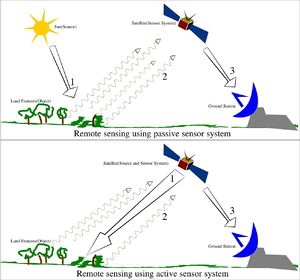Remote sensing
| Exploring for Oil and Gas Traps | |

| |
| Series | Treatise in Petroleum Geology |
|---|---|
| Part | Predicting the occurrence of oil and gas traps |
| Chapter | Exploring for structural traps |
| Author | R.A. Nelson, T.L. Patton, S. Serra |
| Link | Web page |
| Store | AAPG Store |

Information provided
Remote sensing data such as satellite imagery can help us examine regional structural fabrics, patterns, and contacts. Detailed mapping can be done using high-resolution satellite imagery and both high-altitude and low-level photography. The infrared bands on satellite imagery minimize the blurring effects of haze. Radar imagery removes the effects of haze and clouds.
Types
There are four types of remote sensing imagery used when exploring for structural traps:
- Satellite imagery
- High-altitude photography
- Low-level aerial photographs
- Side-looking airborne radar (SLAR) and/or sonar
The following table indicates the coverage and resolution of the various types of satellite imagery.
| Type | Single Scene Coverage (km) | Resolution (m) |
|---|---|---|
| Landsat MSS | 185 × 170 | 80 |
| Landsat TM | 185 × 170 | 30 |
| SPOT | 60 × 60 | 20 (color), 10 (b&w) |
| Soyuz | 40 × 40 | 2 |
How to get it
Remote sensing imagery can be obtained from the following sources:
- Directly from vendors or foreign governments for satellite or high-altitude data or by using a contractor as an intermediary for obtaining and/or processing the imagery
- From published sources such as the proceedings from conferences and topical meetings
- Directly contracting low-altitude aerial photography or, in the U.S., obtaining existing surveys from the Department of Interior or Department of Agriculture (In foreign locations, such surveys often require local government approval and involvement.)
U.S. sources for high-altitude photography, low-level aerial photography, and SLAR are listed in the table below.
| Type of Imagery | Sources |
|---|---|
| High-altitude photography |
|
| Low-level aerial photographs |
|
| Side Looking Airborne Radar (SLAR) |
|
Where to use it
Remote sensing data are useful in all structural terranes but are especially important in remote areas where local topographic and geological control is absent or unobtainable.
In hydrocarbon exploration, remote sensing data is primarily used to (1) examine and map the surface geology in and around a concession area and (2) check terrain conditions and access routes for geologic fieldwork, seismic surveys, well locations, pipeline routes, and environmental hazards.
Examples of use
- Sabins, F. F. Jr., 1998b, Remote sensing for petroleum exploration, part 2: case histories: The Leading Edge, vol. 17, p. 623–626, DOI: 10.1190/1.1438015.
- Prost, G. L. 1994, Remote Sensing for Geologists: A Guide to Image Interpretation: Gordon and Breach Science Publishers, 326 p.
- Insley, M. W., F. X. Murphy, D. Naylor, and M. Critchley, 1996, The use of satellite imagery in the validation and verification of structural interpretations for hydrocarbon exploration in Pakistan and Yemen, in P. G. Buchanan and D. A. Nieuwland, eds., Modern Developments in Structural Interpretation, Validation and Modeling: Geological Society of London Special Publication 99, p. 321–343.
- Halbouty, M. T., 1980, Geologic significance of Landsat data for 15 giant oil and gas fields: AAPG Bulletin, vol. 64, p. 8–36.
- Foster, N. H., and E. A. Beaumont, eds., 1992, Photogeology and photogeomorphology: AAPG Treatise of Petroleum Geology Reprint Series 18, 555 p.
- Beauchamp, W., M. Barazangi, A. Demnati, and M. El Alji, 1996, Intracontinental rifting and inversion: Missour Basin and Atlas Mountains, Morocco: AAPG Bulletin, vol. 80, p. 1459–1482.
- Allenby, R. J., 1987, Origin of the Bolivian Andean orocline: a geologic study utilizing Landsat and Shuttle Imaging Radar: Tectonophysics, vol. 142, p. 137–154, DOI:10.1016/0040-1951(87)90119-3.
- Sosromihardjo, S. P. C., 1988, Structural analysis of the north Sumatra Basin with emphasis on synthetic aperture radar data: Proceedings of the Indonesian Petroleum Association, p. 187–209.
- Sabins, F. F. Jr., 1998a, Remote sensing for petroleum exploration, part 1: overview of imaging systems: The Leading Edge, vol. 17, p. 467–470, DOI: 10.1190/1.1437991.
- Sabins, F. F. Jr., 1987, Remote Sensing, Principles and Interpretation: New York, W. H. Freeman Company, 449 p.
See also
- Frontier reconnaissance techniques and tools
- Plate tectonic studies
- Potential fields
- Structural geology fieldwork
- Natural analogs